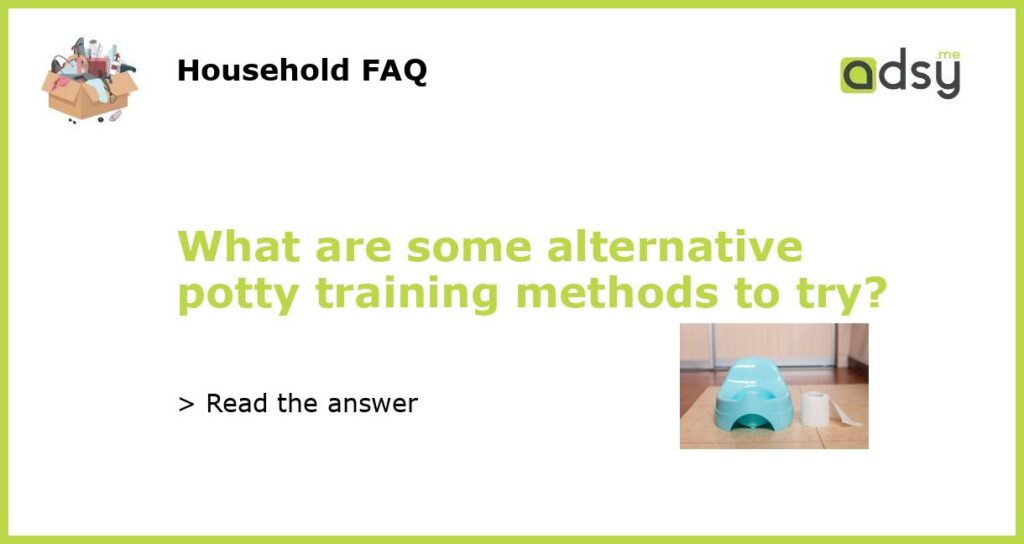The 3-Day Potty Training Method
The 3-Day Potty Training Method is a popular alternative method for potty training that aims to have your child fully trained in just three days. It is an intensive approach that requires a dedicated and focused effort from both parent and child. The key principles of this method are:
- Close observation: Keep a close eye on your child for cues that they need to use the potty. Encourage them to sit on the potty regularly, especially after meals or drinks.
- Naked time: Allow your child to go naked from the waist down to increase their awareness of their bodily functions and decrease accidents.
- Positive reinforcement: Praise and reward your child every time they successfully use the potty. This can be in the form of stickers, treats, or special privileges.
While the 3-Day Potty Training Method can be effective for some children, it may not work for everyone. It requires a lot of time and dedication from both the parent and child, and some children may need more time to fully grasp the concept of using the potty.
The Elimination Communication Method
The Elimination Communication (EC) Method, also known as infant potty training or natural infant hygiene, is a method that involves tuning in to your baby’s natural cues and rhythms to help them use the toilet from a very young age, typically starting as early as birth. The key principles of this method are:
- Observation and communication: Pay close attention to your baby’s facial expressions, body language, and vocal cues to determine when they need to eliminate. Respond promptly by taking them to a designated potty area.
- Bare-bottom time: Allow your baby to go diaper-free during designated times to increase their awareness of their bodily functions and encourage them to use the potty.
- Timing and catching: Learn your baby’s elimination patterns and try to anticipate when they will need to go. Gently hold them over a potty or bowl and make a cue sound or word to associate with elimination.
The Elimination Communication Method can be effective in reducing diaper dependence and promoting early toilet training. However, it requires a high level of commitment from the parent and may not be suitable for all families, especially those with limited time or resources.
The Booty Camp Method
The Booty Camp Method is a structured and intensive potty training method that aims to have your child fully trained within a short timeframe, usually within one week. This method is known for its firm and consistent approach. The key principles of the Booty Camp Method include:
- Preparation: Choose a designated week to focus solely on potty training. Stock up on training pants, underwear, and other necessary supplies.
- Routine and repetition: Establish a consistent toilet routine, including regular potty breaks, and reinforce the importance of using the potty. Encourage your child to sit on the potty every 30-60 minutes, even if they don’t feel the need to go.
- No-nonsense approach: Avoid using diapers or pull-ups during the training period. Instead, switch directly to underwear or training pants to promote independence and increase awareness of accidents.
The Booty Camp Method can be effective for children who respond well to structure and consistency. However, it can be quite demanding for both the parent and child, requiring a dedicated week of focus and continuous reinforcement.
The Child-Oriented Approach
The Child-Oriented Approach, also known as the child-led or readiness method, focuses on waiting for your child to show signs of readiness before beginning the potty training process. This method is grounded in the belief that children should have control over their bodily functions and be willing and able to participate in the learning process. The key principles of the Child-Oriented Approach include:
- Readiness signals: Look for signs that your child may be ready for potty training, such as showing interest in the potty, staying dry for longer periods, or expressing discomfort with wet or dirty diapers.
- Collaboration and partnership: Involve your child in the decision-making process and give them a sense of ownership by allowing them to choose their own potty or underwear.
- Gentle encouragement: Support your child’s efforts and offer positive reinforcement whenever they show progress, even if it’s just small steps.
The Child-Oriented Approach may take longer than other methods but is often less stressful for both the parent and child. It respects the child’s autonomy and allows them to take the lead in their own potty training journey.
The Montessori Method
The Montessori Method takes a unique approach to potty training by emphasizing independence and self-care. Developed by Italian physician and educator Maria Montessori, this method encourages children to take an active role in their own personal care and hygiene. The key principles of the Montessori Method include:
- Access to a child-sized potty: Provide your child with their own child-sized potty that they can easily access and use independently.
- Education and guidance: Teach your child about their body and the purpose of the potty in a simple and age-appropriate manner. Demonstrate how to use the potty and encourage them to imitate your actions.
- Promotion of self-care skills: Encourage your child to take responsibility for their toilet needs by allowing them to choose when to use the potty and assisting them in cleaning themselves afterward.
The Montessori Method promotes independence, self-confidence, and self-discipline. It aligns with the Montessori philosophy of education and can be an effective approach for children who thrive in an environment that emphasizes self-directed learning and exploration.






